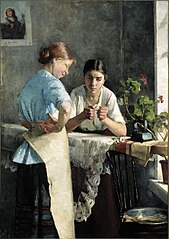Helena Westermarck
Helena Westermarck | |
|---|---|
 Westermarck in 1894 | |
| Born | Helena Charlotta Westermarck 20 November 1857 |
| Died | 5 April 1938 (aged 80) Helsinki, Finland |
| Nationality | Finnish |
| Known for | Painter, writer |
Helena Charlotta Westermarck (20 November 1857, Helsinki – 5 April 1938, Helsinki) was a Swedish-speaking Finnish artist and writer.[1][2][3] She is known for her pioneering biographies of women.[4]
Biography
[edit]Westermarck studied art at the Drawing School of the Finnish Art Society and the private academy of Adolf von Becker. During her studies, she met Helene Schjerfbeck, who remained a close friend for the rest of their lives. Westermarck and Schjerfbeck were a part of a group of female artists, "the painter sisters." This group included Maria Wiik and Elin Danielson-Gambogi.[5]
Westermarck worked for long periods in France, often in the company of Schjerfbeck, and developed a sensible realistic style especially with portraits and figure compositions. At the Exposition Universelle (1889), she received honorable mention for her painting Strykerskor.

After contracting tuberculosis in 1884, she abandoned painting and devoted herself to writing as a critic.[6]
Westermarck began her writing career as a novelist. Her novels can be looked at as an artifact of women's history and the everyday life of upper- and middle-class women.[4] She edited the Swedish-language women's magazine Nutid.[7]
Westermarck also made a significant contribution as a researcher through her cultural and historical works. In her research, she worked beside her brother, Edvard Westermarck, in the British Library.[4] She began her pioneering biographic works in the early 1890s. These works include a series of biographies of female figures. Many of her biographies are on unknown female painters who were "discovered" in the 1980s, including Mathilda Rotkirch (1926). She also wrote about women who were pioneers in their respective fields, including Elisabeth Blomqvist (1916–17), Adelaide Ehrnrooth (1928), and Rosina Heikel (1930).
Westermarck's memoir was published in 1941.[8]
Selected works
[edit]- Ur studieboken I–II: Berättelser och utkast, 1890–91
- Framåt. Berättelse, 1894
- George Eliot och den engelska naturalistiska romanen. En litterär studie, 1894
- Nyländska folksagor berättade för ungdom af Helena Westermarck, 1897
- Lifvets seger, 1898
- "Tecken och minnesskrift från adertonhundratalet" I-III, 1900–1911:
- I I fru Ulrikas hem. Interiör från farmödrarnas tid, 1900
- II Ljud i natten. Berättelse, 1903
- III Vandrare. Roman, 1911
- Fredrika Runeberg. En litterär studie, 1904
- Dolda makter. Bilder och hägringar, 1905
- Bönhörelse. En historia, 1909
- Kvinnospår. Kulturbilder från 1800-talets förra del, 1913
- Elisabeth Blomqvist. Hennes Liv och gärning I–II, 1916–17
- Vägvisare. Berättelse, 1922
- Mathilda Rotkirch, Finlands första målarinna. En kulturbild, 1926
- Adelaïde Ehrnrooth. Kvinnospår i finländskt kulturliv, 1928
- Finlands första kvinnliga läkare Rosina Heikel, 1930
- Tre konstnärinnor. Fanny Churberg, Maria Wiik och Sigrid af Forselles, 1937
- Mina levnadsminnen, 1941
Gallery
[edit]-
Portrait of watchmaker Anders Wilhelm Felixzon, unknown date
-
General Albert Westermarck, c. 1880
-
Abyssinian, 1880
-
Colarossi's Son, 1881
-
Ironesses; An Important Question, 1883
-
An Old Woman, 1883
-
Children in a Cottage, 1892
See also
[edit]References
[edit]- ^ Konttinen, Riitta (22 April 2015). "Westermarck, Helena (1857–1938)". Kansallisbiografia. Retrieved 18 August 2020.
- ^ "Westermarck, Helena". Kirjasampo. Retrieved 18 August 2020.
- ^ Uimonen, Anu (8 September 2009). "Taiteilija kysyi tärkeitä kysymyksiä". Helsingin Sanomat. Retrieved 18 August 2020.
- ^ a b c Women telling nations. Amelia Sanz Cabrerizo, Francesca Scott, Suzanna van Dijk. Amsterdam: Editions Rodopi. 2014. ISBN 978-94-012-1112-3. OCLC 897069728.
{{cite book}}: CS1 maint: others (link) - ^ "Description of Portrait of Helena Westermarck". taide.art.
- ^ Alarto, Anne; Kyrki, Irma; Saraste, Maija. "Sara's sisters: The tradition of women's literature in Finland from the 19th century to the early 20th century" (PDF) (in Finnish). Oulu City Library-Provincial Library. Retrieved 13 November 2019.
- ^ Julia Dahlberg (2018). "When artists became intellectuals:Female artistic persona and science as a significant other". Persona Studies. 4 (1): 64. doi:10.21153/ps2018vol4no1art688.
- ^ "Westermarck, Helena" (in Swedish). Uppslagsverket Finland. Retrieved 26 June 2016.
External links
[edit]- Helene Westermarck at Nordisk familjebok – Uggleupplagan. 32. Werth–Väderkvarn / col. 45–46 (1921).
- Dahlberg, Julia (2018). "When Artists Became Intellectuals. Female Artistic Persona and Science as a Significant Other", Persona Studies 4:1 (2018), 60–73.
- 1857 births
- 1938 deaths
- Artists from Helsinki
- Finnish women artists
- Swedish women artists
- 19th-century Finnish women writers
- 19th-century Swedish women writers
- 20th-century Finnish women writers
- 20th-century Swedish women writers
- 19th-century Finnish writers
- 19th-century Swedish writers
- 20th-century Finnish writers
- 20th-century Swedish writers
- Writers from Helsinki
- Finnish expatriates in France
- Swedish-speaking Finns
- Writers from the Russian Empire







